Brazilian nickel mine reduces ore dilution by 2.2% through optimized material blending
Achieving an accurate material blend is a common challenge for many open-pit mining organizations. Mines that are comprised of multiple material types or significantly-varying material grades are especially burdened by this challenge, as the difficulty to dig the correct material/grade and manage the multiple stockpiles that often result, without diluting the ore they produce, increases exponentially. The financial burden that accumulates from these blend inaccuracies can be significant, especially when considering their downstream effects on crushing and material processing.
An open-pit mine in Brazil extracts nickel ore; nearby contaminating elements, however, often complicate their material blending accuracy and dilute their ore output. After implementing the DISPATCH® Fleet Management System (FMS) and ProVision® High-Precision Machine Guidance system, the mine reduced their ore dilution by 2.2% by optimizing their material blending practices and improving operator accuracy.
LOCATION
Brazil
GOAL
Reduce nickel ore dilution by at least 1%
RESULTS
2.2% decrease in total ore dilution, representing a 1.1% increase in material grade output and an estimated $5.7M in additional revenue per year
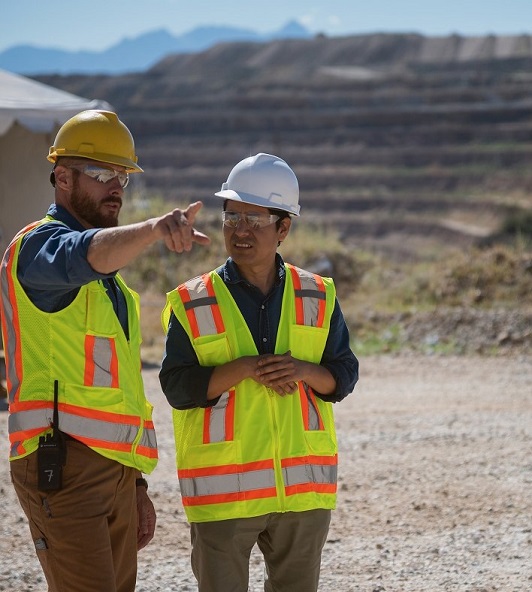
Challenge
Prior to Modular Mining’s involvement, the mine relied on physical stakes to identify ore and dig boundaries (figure 1). While common, this process can put miner safety at risk as a result of the challenging terrain they have to hike to both place the stakes, and later inspect the dig progress. It can also result in over- or under-digging, or incorrect material/grade selection, because operators can’t easily identify the limits of their dig zones.
The problem is further exacerbated for loading equipment operators working at night or in inclement weather, who have a hard time seeing the stakes. As a result, the mine’s shovel operators were unknowingly digging outside of their dig boundaries.
Figure 1. The mine relied on physical stakes to identify ore and dig boundaries, which were difficult to see.
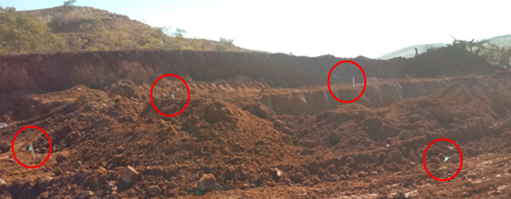
This diluted the mine’s ore output by 15% on average and resulted in high element variances (figure 2).
Additionally, the mine’s incumbent FMS lacked material blending functionality, so the mine manually managed its blend via multiple temporary stockpiles; this also contributed to their nickel dilution. The mine reached out to Modular Mining for help in reducing their ore dilution by at least 1%.
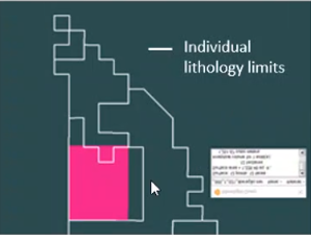
Planned
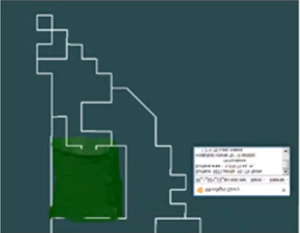
Actual
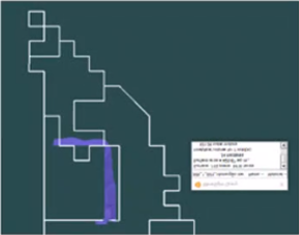
Dilution
Figure 2. Without clear material delineation, operators were unknowingly over-digging, which diluted the mine’s ore output.
(Image from the mine’s Mine Planning software)
Solution
Together with Modular Mining’s deployment and Performance Assurance (PA) teams, the mine implemented the DISPATCH system, as well as its optional Blending and Inventory modules, on 12 haul trucks, as an initial test phase. They also installed the ProVision Machine Guidance system with the Bucket Positioning System (BPS) on two of the mine’s backhoes.
Expansion to the mine’s full fleet of trucks, loading equipment, and dozers was planned for a subsequent phase, pending the successful results of the 1% ore dilution reduction KPI that Modular Mining and mine personnel mutually established for this initial phase.
After installing and configuring the systems and validating functionality, Modular Mining thoroughly trained the mine’s dispatchers, supervisors, equipment operators, and other users to ensure system proficiency and understanding.
ProVision Machine Guidance for
Loading Equipment
The ProVision system leverages high-precision GNSS positioning to guide operators of shovels, backhoes, and loaders to dig the right material, day or night, in real time. The system uses data from the mine plan to automatically and visually delineate materials and grades, leveraging a high-resolution 10” in-cab display to help operators easily differentiate material boundaries.
The Bucket Positioning System (BPS) leverages sensors to determine the loading unit’s precise and current bucket position, given the intermediate positions and inclination of the boom, stick, and bucket. BPS sends this information to the ProVision system in real time to help loading operators dig even more precisely (to the centimeter, in some cases). Together, the ProVision system and BPS help miners ensure correct material grades are dug and loaded – more accurately, efficiently, and safely than staking methods can.
DISPATCH Blending Module
The Blending module helps mines:
- Automate blending at crushers
- Maximize stockpile management and efficiency
- Reduce material re-handle
Leveraging this module, the DISPATCH FMS considers crusher blend constraints, then automatically assigns trucks directly to a crusher or specific stockpile to meet those constraints.
The module optimizes productivity by minimizing or maximizing multiple material grade variables to achieve the final desired ore grade.
DISPATCH Dynamic Material Inventory Reporting Module
After every load or dump, the inventory module:
- Tracks the amount of material at blast, stockpiles, and dump locations
- Tracks grades to improve blend control
- Updates inventory records with new survey data
- Reconciles calculated and surveyed quantities of material
Since this functionality occurs after every load or dump, it optimizes control over the total material mined and temporarily stored in piles. It also provides the most accurate data available, should manual management or intervention be required.
Alongside the blending module, the dynamic material inventory reporting module wields optimal ore grade control, especially for operations whose grades are highly variable or highly expansive.
Results
After implementing the DISPATCH and ProVision systems on the select portion of the fleet, the mine’s ore dilution decreased by 2.2% in those equipment units (figure 3) as a result of:
- Improved backhoe operator awareness of actual dig limits, based on real-time progress facilitated by HP-GNSS positioning accuracy and BPS capabilities
- Increased confidence of the material and grade being dumped into stockpiles and crushers
- Improved blending accuracy and efficiency, directly at the crusher or via stockpiles
- Reduced material re-handle as a result of more material being taken directly from the pit to the crusher
- Improved stockpile efficiency and usage (which ultimately resulted in a marked decrease in the number of temporary stockpiles created)
- Improved safety factors as a result of better accuracy of slope angles according to plan, which helps ensure slope stability and water drainage
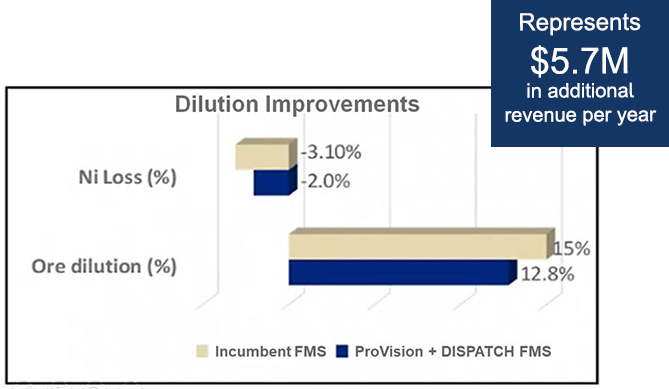
Figure 3. Nickel dilution decreased by 2.2% after implementing the ProVision and DISPATCH systems. Consequently, nickel loss improved by 1.1%, equating to a higher-grade ore being sent to the crusher. Extrapolated over the mine’s entire fleet, this higher-grade ore represents an estimated potential of $5.7 million in additional revenue per year, per the miner’s calculations.
This reduction subsequently increased the high-grade nickel content being received by the crusher by 1.1%; after extrapolating this increase across their entire fleet, the mine estimated an additional 440 tons of high-grade material output, per year. Using a conservative US$13,000/ton nickel commodity price, this increased material output represents an estimated increase in revenue of US$5.7M per year.
Replacing their incumbent FMS with the DISPATCH system also helped the mine increase their truck productivity by nearly 2.2% in average tons per hour, compared to the trucks still equipped with the incumbent FMS. Their truck utilization also benefitted from the FMS replacement, increasing by more than 6% on average when compared to the trucks still equipped with the prior system.
Conclusion
By replacing the mine’s previous FMS with the DISPATCH system’s superior algorithms and material blending capabilities, and by implementing the ProVision high-precision machine guidance system on the mine’s loading units, Modular Mining’s personnel and technologies came together to provide the total solution needed.
Optimizing their material blending process helped the mine drive several substantial improvements, including:
- 2.2% reduction in ore dilution
- 1.1% reduction in nickel ore loss, representing a potential $5.7M in additional revenue per year
- 2.2% average increase in truck tons per hour
- 6% average increase in truck utilization
- Improved safety due to elimination of the manual stake and survey process
Now that the initial KPI of 1% reduction in ore dilution has been surpassed, and as we progress together into the subsequent phases of this project, we’re looking forward to helping the mine continue driving productivity improvements and operational efficiencies.

